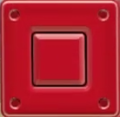Dotted-Line Block: Difference between revisions
No edit summary |
m (Text replacement - "{{nav templates" to "{{navboxes") |
||
| Line 82: | Line 82: | ||
<references/> | <references/> | ||
{{ | {{navboxes| | ||
{{Blocks}} | {{Blocks}} | ||
{{SMW}} | {{SMW}} | ||
Revision as of 16:01, May 23, 2024
Dotted-Line Blocks[1] (originally formatted without a hyphen)[2] are transparent objects found in several games of the Super Mario franchise, such as Super Mario World (and its reissue), Super Mario World 2: Yoshi's Island (and its reissue), Yoshi's Island DS, New Super Mario Bros. Wii, and Super Mario Run. They represent that they can be solid when a switch is triggered, rather than blocks appearing from nothing. In Super Mario World, they come in four colors and turn into ! Blocks once the player hits the ! Switch in the Switch Palace of the corresponding color. In Super Mario World 2: Yoshi's Island, Yoshi's Island DS, Yoshi's New Island, and Yoshi's Woolly World, after the player hits a nearby ! Switch, the Dotted-Line Blocks temporarily become ! Blocks and are able to be used as platforms. Dotted-Line Blocks in New Super Mario Bros. Wii can turn into and revert from red blocks after the player presses the red ! Switches in World 3. In New Super Mario Bros. and Super Mario Run, red (yellow in Run) ! Switches can change Dotted-Line Blocks into red blocks for a limited time.
Similar objects called semi-visible blocks[3] appear in Super Mario 64 and its remake, Super Mario 64 DS, where they turn solid and are able to be used after the player hits the ! Switch or ? Switch on the Tower of the Wing Cap in both versions and Vanish Cap Under the Moat and the Cavern of the Metal Cap in the N64 version only.
In Super Mario Maker 2, Dotted-Line Blocks can be triggered by ON/OFF Switches, with only the red blocks becoming solid when they are on and only the blue blocks becoming solid when they are off. In the Super Mario Bros. 3 style, they are depicted having a smiling face, while every other style depicts them as faceless blocks. As of the version 2.0 update, P Blocks also appear as an outline like Dotted-Line Blocks while inactive. Although previously not available in the Super Mario 3D World style, Dotted-Line Blocks were added in the version 3.0.0 update released on April 22, 2020.
In the Nintendo Switch version of Mario vs. Donkey Kong, inactive Color Blocks are redesigned to have a similar design to Dotted-Line Blocks.
Gallery
Super Mario Maker 2 (Super Mario Bros. style)
Super Mario Maker 2 (Super Mario Bros. 3 style)
Super Mario Maker 2 (New Super Mario Bros. U style)
Names in other languages
| Language | Name | Meaning | Notes |
|---|---|---|---|
| Chinese | 虚线砖块 (Simplified) 虛線磚塊 (Traditional)[?] Xūxiàn Zhuānkuài |
Dotted-Line Block | |
| Dutch | Stippellijnblok[?] | Dotted Line Block | |
| French | Bloc en pointillés[6](Super Mario World, Super Mario Maker 2) | Dotted block | |
| Bloc réversible[7] (Super Mario Bros. Deluxe) | Reversible block | ||
| German | Umriss-Block[?] | Outline Block | |
| Italian | Blocchi di Contorni[8] (Super Mario Bros. Deluxe) | Outline block | |
| Blocco semivisibile[9] (Super Mario 64) | Semi-visible block | ||
| Blocco Trasparente[10] (Super Mario 64, alternative name) | Transparent block | ||
| Blocco tratteggiato (Super Mario Maker 2)[?] | Dotted block | ||
| Portuguese | Bloco Pontilhado[?] | Dotted Block | |
| Russian | Пунктирный блок[?] Punktirnyy blok |
Dotted Block | |
| Spanish (NOA) | Bloque de puntos[?] | Dotted block |
References
- ^ Nintendo (2002). Super Mario World: Super Mario Advance 2 instruction booklet. Nintendo of America (American English). Page 49.
- ^ Nintendo (1991). Super Mario World instruction booklet. Nintendo of America (American English). Page 21.
- ^ Nintendo (1996). Super Mario 64 instruction booklet. Redmond: Nintendo of America. Page 19.
- ^ スーパーマリオワールド (Sūpā Mario Wārudo instruction booklet (fold-out). Nintendo (Japanese).
- ^ Nintendo (1996). スーパーマリオ
64 (Sūpā Mario Rokujūyon) instruction booklet. Nintendo. Page 19. - ^ Super Mario World instruction booklet. Nintendo (French). Page 21.
- ^ Super Mario Bros. Deluxe French Nintendo 3DS Virtual Console digital manual. Page 12.
- ^ Nintendo (1999). Super Mario Bros. Deluxe European instruction manual. Nintendo of Europe (Italian). Page 112.
- ^ Nintendo. Super Mario 64 European manual. Nintendo of Europe (Italian). Page 38.
- ^ Super Mario Bros. Enciclopedia. Page 92.
- Blocks
- New Super Mario Bros. 2 objects
- New Super Mario Bros. Wii objects
- Super Mario 64 objects
- Super Mario 64 DS objects
- Super Mario Advance 4: Super Mario Bros. 3 objects
- Super Mario Maker 2 objects
- Super Mario Run objects
- Super Mario World objects
- Super Mario World 2: Yoshi's Island objects
- Yoshi's Island DS objects
- Yoshi's Island: Super Mario Advance 3
- Yoshi's New Island objects
- Yoshi's Woolly World objects





























